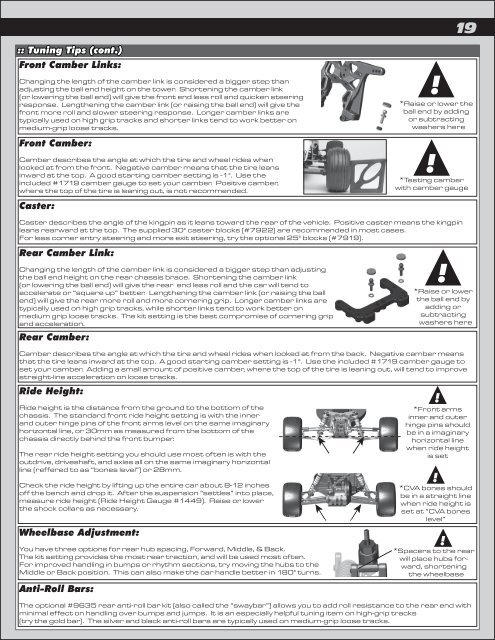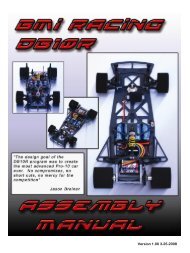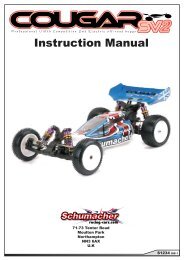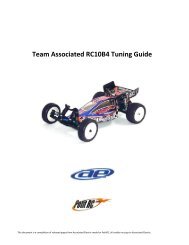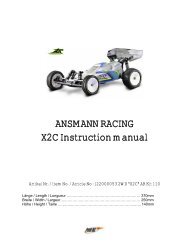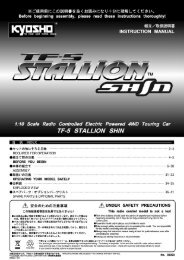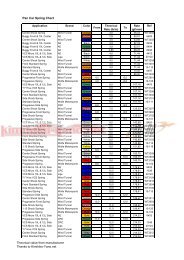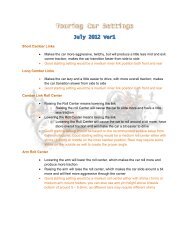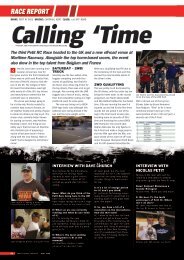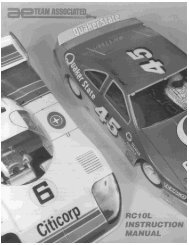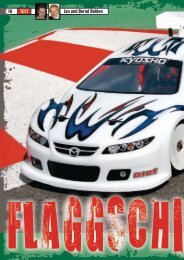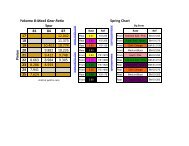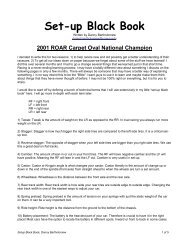You also want an ePaper? Increase the reach of your titles
YUMPU automatically turns print PDFs into web optimized ePapers that Google loves.
19<br />
:: Tuning Tips (cont.)<br />
Front Camber Links:<br />
Changing the length of the camber link is considered a bigger step than<br />
adjusting the ball end height on the tower. Shortening the camber link<br />
(or lowering the ball end) will give the front end less roll and quicken steering<br />
response. Lengthening the camber link (or raising the ball end) will give the<br />
front more roll and slower steering response. Longer camber links are<br />
typically used on high grip tracks and shorter links tend to work better on<br />
medium-grip loose tracks.<br />
Front Camber:<br />
Camber describes the angle at which the tire and wheel rides when<br />
looked at from the front. Negative camber means that the tire leans<br />
inward at the top. A good starting camber setting is -1°. Use the<br />
included #1719 camber gauge to set your camber. Positive camber,<br />
where the top of the tire is leaning out, is not recommended.<br />
Caster:<br />
!<br />
*Raise or lower the<br />
ball end by adding<br />
or subtracting<br />
washers here<br />
!<br />
*Testing camber<br />
with camber gauge<br />
Caster describes the angle of the kingpin as it leans toward the rear of the vehicle. Positive caster means the kingpin<br />
leans rearward at the top. The supplied 30° caster blocks (#7922) are recommended in most cases.<br />
For less corner entry steering and more exit steering, try the optional 25° blocks (#7919).<br />
Rear Camber Link:<br />
Changing the length of the camber link is considered a bigger step than adjusting<br />
the ball end height on the rear chassis brace. Shortening the camber link<br />
(or lowering the ball end) will give the rear end less roll and the car will tend to<br />
accelerate or “square up” better. Lengthening the camber link (or raising the ball<br />
end) will give the rear more roll and more cornering grip. Longer camber links are<br />
typically used on high grip tracks, while shorter links tend to work better on<br />
medium grip loose tracks. The kit setting is the best compromise of cornering grip<br />
and acceleration.<br />
Rear Camber:<br />
Camber describes the angle at which the tire and wheel rides when looked at from the back. Negative camber means<br />
that the tire leans inward at the top. A good starting camber setting is -1°. Use the included #1719 camber gauge to<br />
set your camber. Adding a small amount of positive camber, where the top of the tire is leaning out, will tend to improve<br />
straight-line acceleration on loose tracks.<br />
Ride Height:<br />
Ride height is the distance from the ground to the bottom of the<br />
chassis. The standard front ride height setting is with the inner<br />
and outer hinge pins of the front arms level on the same imaginary<br />
horizontal line, or 30mm as measured from the bottom of the<br />
chassis directly behind the front bumper.<br />
The rear ride height setting you should use most often is with the<br />
outdrive, driveshaft, and axles all on the same imaginary horizontal<br />
line (reffered to as “bones level”) or 28mm.<br />
Check the ride height by lifting up the entire car about 8-12 inches<br />
off the bench and drop it. After the suspension “settles” into place,<br />
measure ride height (Ride Height Gauge #1449). Raise or lower<br />
the shock collars as necessary.<br />
Wheelbase Adjustment:<br />
You have three options for rear hub spacing, Forward, Middle, & Back.<br />
The kit setting provides the most rear traction, and will be used most often.<br />
For improved handling in bumps or rhythm sections, try moving the hubs to the<br />
Middle or Back position. This can also make the car handle better in 180° turns.<br />
Anti-Roll Bars:<br />
*Raise or lower<br />
the ball end by<br />
adding or<br />
subtracting<br />
washers here<br />
*Front arms<br />
inner and outer<br />
hinge pins should<br />
be in a imaginary<br />
horizontal line<br />
when ride height<br />
is set<br />
*CVA bones should<br />
be in a straight line<br />
when ride height is<br />
set at “CVA bones<br />
level”<br />
*Spacers to the rear<br />
will place hubs forward,<br />
shortening<br />
the wheelbase<br />
The optional #9635 rear anti-roll bar kit (also called the “swaybar”) allows you to add roll resistance to the rear end with<br />
minimal effect on handling over bumps and jumps. It is an especially helpful tuning item on high-grip tracks<br />
(try the gold bar). The silver and black anti-roll bars are typically used on medium-grip loose tracks.<br />
!<br />
!<br />
!<br />
!


